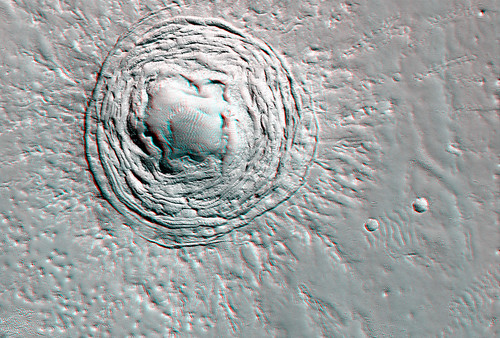Mars has depression.
Well, a depression. You’d have one too if you had a great gaping pit on your surface that seems to defy explanation.
 |
| A bowl-shaped pit on Mars. Click to brobdignangify (or get the original version). Courtesy NASA/JPL/University of Arizona. |
Isn’t that awesome in 3D? Use red/green glasses (red on the left) to see this in all its bichromatic anaglyphic glory. This is a red/green stereo pair from the HiRISE camera onboard Mars Reconnaissance Orbiter, my favorite camera in the solar system right now.
This crater-like feature is located in what’s thought to be a mud flow, near a volcano. It’s almost certainly not an impact crater, since it lacks many of the features associated with impacts (no raised rim, for example). It looks like the surface collapsed, which makes some sense. There could have been water or ice under it, and some volcanic event happened to remove it, which also removed the support. Whoomf! Sink hole.
Concentric rings are common in such things, due to the way the material falls in on itself (watch a video of an ant lion digging a pit in sand and you’ll see similar features). But if you look around it, you see radial features called rays. Those are usually due to impact events which throw out streamers of materials! But rays are also usually thin, a layer of dust coating the surface. These rays have depth and width, as if they are from something flowing out of the pit.
I’m no geomorphologist, so I’m guessing, but I wonder if the collapse of the denser surface forced lower density water up, filling the depression with water and making it overflow the pit. Think of jamming a sock into a nearly full glass to get the picture. Or maybe water was squeezed out of the layers just below the surface, and it flowed away, boiling in the low pressure. What a sight that would be!
I don’t think it’s all that easy to say exactly what happened here. But the 3D view might give scientists some insight into what happened here – it provides them with the angle of the sloping sides, for example, as well as how much volume was lost, which can be used to get information about the collapsed material.
And in case you didn’t notice, the rippling in the very center? Those are sand dunes. So very cool.